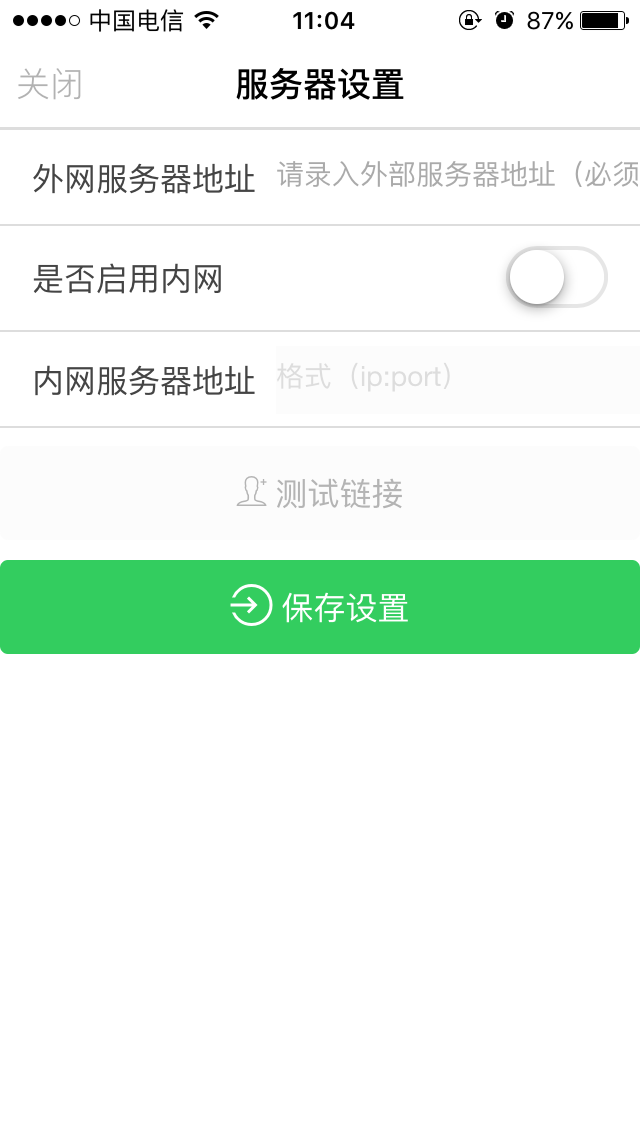ionic 运行过程中动态切换API服务器地址
ionic 运行过程中动态切换API服务器地址
keywords:
ionic,phonegap,cordova,网络制式,动态切换,变更,API,服务器地址,$resource,localstorage,url
场景、需求
场景
APP以项目的形式提供,一个客户需要部署一套服务器,一个APP,所以APP的后台服务器地址不能写死。而且要求如果有wifi且在内网,需要用内网服务器地址,如果用3G或者4G,则需切换为外网服务器地址
需求
APP第一次运行,如果没有设置过服务器地址,需要设置好后台服务器地址(含内网和外网,外网是必选,内网是可选)
APP运行过程中,如果用户手机网络制式发生改变,则需要根据移动网络制式选择合适的服务器地址
原有URL的设置
以前APP的API地址,是直接写到一个constant里面,例如:
(function () {
"use strict";
angular.module("gaia.config", [])
.constant("ENV", {
"version": "1.0.1",
"name": "production",
"debug": true,
"api": "http://111.111.111.111:8088/gaia/api",
});
})();
resource的调用
var resource = $resource(ENV.api + '/customer',{},{
login:{
method:'post',
url:ENV.api + '/customer/login'
},
accesstoken:{
method:'get',
url:ENV.api + '/customer/accesstoken'
}
});
方案一
(后面实现方案有部分变动)
保留ENV,APP第一次启动将设置的url存到localstorage里面,在以后每次启动前,从localstorage里面取出来赋值给ENV.api,当网络制式发生改变时,再根据情况赋值改变ENV.api。所有与后台相关的Service 的$resource 的初始化都依赖于ENV.api。
设计的关键点:
- 启动时需要检查localstorage里面是否有url的值,没有则弹出设置页
- ENV.api的赋值一定要先于APP的启动,否则Service的$resource的url 都为空了
- Service 需要将$resource的定义封装并开放出接口,便于后期改变$resource的url定义
- 网络制式改变,ENV.api的改变,Service的$resource的重新定义
设置页面
请忽略美观(-__-)b

Service $resource 声明方式的改造:
var resource = null;
var _initResource = function(apiUrl){
resource = $resource(apiUrl + '/customer',{},{
login:{
method:'post',
url:apiUrl + '/customer/login'
},
accesstoken:{
method:'get',
url:apiUrl + '/customer/accesstoken'
}
});
};
_initResource(ENV.api);
return {
initResource:function(url){
_initResource(url);
},
.....
新增Service,统一变更$resource
每次变更就调用先设置ENV.api,再_Sys.changeResource(ENV.api);
(function () {
'use strict';
angular.module('gaia.services')
.factory('_Sys', function (ENV, User, Projects, Plans) {
return {
changeResource: function (url) {
User.initResource(url);
Projects.initResource(url);
Plans.initResource(url);
}
};
});
})();
网络制式切换,调整URL
关于网络制式的监控的相关细节见:ngcordova 监控网络制式改变
$rootScope.$on('$cordovaNetwork:online', function (event, networkState) {
var type = $cordovaNetwork.getNetwork();
if (type == Connection.WIFI) {
var wifiApi = Settings.getWIFIAPI();
if (wifiApi) {
//test方法定义见方案二Setting定义
Settings.test(wifiApi).$promise.then(function (response) {
if (response.success) {
//切换内网服务器地址中....
_Sys.changeResource(wifiApi);
}
}, function (e) {});
}
}
else if (type == Connection.CELL_4G || type == Connection.CELL_3G) {
var wlanApi = Settings.getAPI();
//切换移动网(3G|4G)服务器地址中....
_Sys.changeResource(wlanApi);
}
});
方案二
大体思路同方案一,只是在思想方案一过程中,又是localstorage 又是ENV.api,各种判断,给绕晕了,后来一想,url最终还是以localstorage里面存储的为准,何不抛弃ENV.api,实现大统一(●ˇ∀ˇ●)
设计思路改动点:
- 抛弃ENV.api,所有获取和设置,均以localstorage为准
- 简化、优化API地址的获取和设置,见下面Setting Service 的定义(新增getAPI(),getWIFIAPI())
- 所有Service $resource中的URL,均取于Setting.getAPI()方法
- 进入第一个页面前,判断Setting.getAPI()的值是否存在,不存在则弹出设置页面进行设置
1.用户设置的API地址,存储到localstorage里面,定义两个基础Service,一个用于localstorage操作,一个用于APP参数设置
//Storage Service 定义
(function(){
'use strict';
angular.module('gaia.services')
.factory('Storage',function($log){
$log.debug("Storage Service init");
return {
set:function(key,data){
return window.localStorage.setItem(key,window.JSON.stringify(data));
},
get:function(key){
return window.JSON.parse(window.localStorage.getItem(key));
},
remove:function(key){
return window.localStorage.removeItem(key);
}
};
});
})();
//Settings Service 定义
(function () {
'use strict';
angular.module('gaia.services')
.factory('Settings', function ($resource, $log, Storage) {
var storageKey = 'settings';
var _settings = Storage.get(storageKey) || {};
var addOn = '/gaia/api';
return {
getSettings: function () {
return _settings;
},
save: function (settings) {
Storage.set(storageKey, settings);
_settings = settings;//改变内存中的_settings,便于每次调用getAPI时都能取到最新值
return settings;
},
getAPI: function () {
if (_settings.wlan) {
return "http://" + _settings.wlan + addOn;
}
return "";
},
getWIFIAPI: function () {
if (_settings.wifiMode && _settings.wifi) {
return "http://" + _settings.wifi + addOn;
}
return "";
},
test: function (url) {
var resource = $resource("http://" + url + addOn + "/test", {}, {
query: {
method: 'get',
isArray: false,
timeout: 2000
}
});
return resource.query();
}
};
});
})();
2.Service $resource 的部分改动
var resource = null;
var _initResource = function(apiUrl){
resource = $resource(apiUrl + '/customer',{},{
login:{
method:'post',
url:apiUrl + '/customer/login'
},
accesstoken:{
method:'get',
url:apiUrl + '/customer/accesstoken'
}
});
};
//将此处的ENV.api 换成Settings.getAPI()
// _initResource(ENV.api);
_initResource(Settings.getAPI());
3.检测是否存在API地址,不存在则弹出设置页面
$scope.api = Settings.getAPI();
$ionicModal.fromTemplateUrl('templates/urlSetting.html', {
scope: $scope
}).then(function (modal) {
$scope.settingModal = modal;
if ((!$scope.api) || ($scope.api.indexOf("http://") === -1)) {
if (window.StatusBar) {
StatusBar.styleDefault();
}
$scope.settingModal.show();
}
});
//保存设置值方法
$scope.saveSettings = function () {
//1.save setting 到localstorage
if (!$scope.settings.wifiMode) {
$scope.settings.wifi = "";
}
Settings.save($scope.settings);
$ionicLoading.show({
noBackdrop: true,
template: "<div><h1><i class='icon ion-checkmark-circled balanced'></i></h1>保存成功</div>",
duration: 1000
});
$scope.api = Settings.getAPI();
//2.变更所有Service 中的resource
_Sys.changeResource($scope.api);
$scope.settingModal.hide();
};
总结
为了实现APP的后台API地址动态改变,只要找到问题的核心,不外乎围绕着API_URL 的获取 和设置 来实现该功能
获取:
- 判断localstroage是否存储了API_URL - 增加判断方法
- 与后台服务器请求相关的Service - 变更$resource 的定义方法,并开放出改变的接口
设置:
- localstroage里面没有API_URL ,弹出页,保存时
- 网络制式发生变化时
【原创】,转载请带上原地址http://www.cnblogs.com/sloong/p/5151019.html

